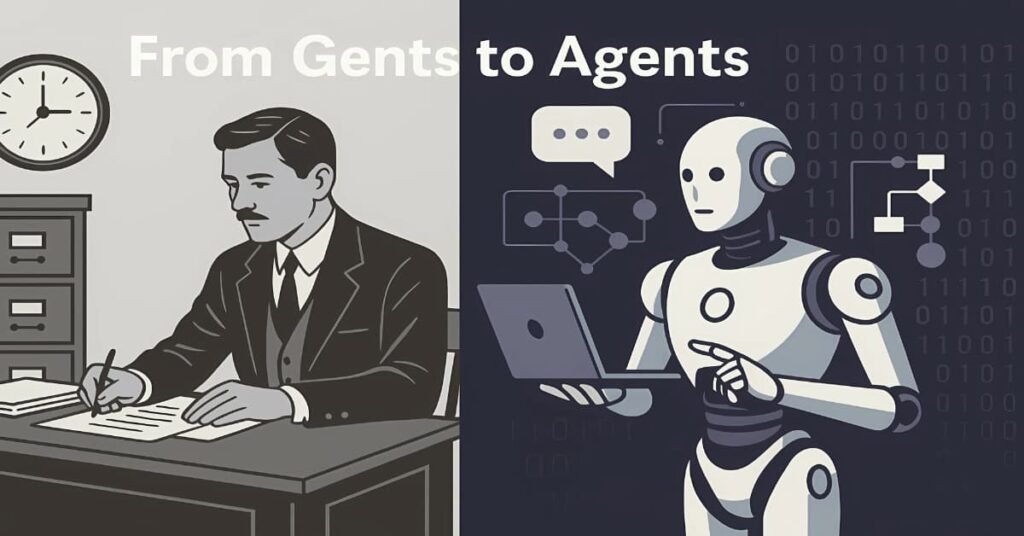As an engineer who turned to data & AI professional, observing the socio-technical landscape, it’s clear that the digital realm is rapidly evolving, ushering in new forms of “workforce” that challenge our historical notions of labour and management.
Just as the “gents” of 1930 commanded their paper empires, a new class of digital “gents”—AI agents—are poised to reshape our world by 2030, with Agentic AI systems acting as their orchestrated syndicates.
Let’s break down these new digital power players:
The AI Agent: The Solo Operator
At its core, an AI Agent is an autonomous software entity engineered for goal-directed task execution within bounded digital environments. Think of them as highly specialized digital employees, akin to the diligent accountant in 1930 meticulously balancing ledgers. They are designed to perceive structured or unstructured inputs, reason over contextual information, and initiate actions toward achieving specific objectives, often acting as substitutes for human users or subsystems.
Key characteristics of an AI Agent include:
- Autonomy: Once deployed, they operate with minimal or no human intervention, perceiving environmental inputs, reasoning with data, and executing actions in real-time. They differ from general-purpose LLMs which are primarily reactive prompt followers.
- Task-Specificity: AI Agents are purpose-built for narrow, well-defined tasks. For example, a single AI agent can automate customer service by leveraging retrieval-augmented LLMs to answer queries and triage tickets, or manage your calendar by interpreting vague commands and identifying optimal time slots.
- Reactivity and Limited Adaptability: They respond to changes in their environment, such as user commands or API responses, and some even integrate rudimentary learning through feedback loops to refine their behaviour.
- Tool-Augmented: Modern AI agents enhance large language models (LLMs) with capabilities for external tool use, function calling, and sequential reasoning. This allows them to fetch real-time information and execute multi-step workflows autonomously, much like a human employee using various office tools.
However, these digital soloists have their limitations. They often lack causal understanding, struggling to distinguish between correlation and causation, which can lead to brittleness in novel situations. They also inherit limitations from LLMs, such as the tendency to “hallucinate” (produce factually incorrect outputs) and suffer from prompt sensitivity. Their planning ability is limited to short horizons, and their overall “agentic properties” like true proactivity or social ability remain incomplete.
Agentic AI: The Collaborative Directorate
While AI Agents are skilled individual performers, Agentic AI represents a more profound shift, embodying complex, multi-agent systems in which specialized agents collaboratively decompose goals, communicate, and coordinate toward shared objectives. This is less like a single accountant and more like an entire corporate department, with different roles working in concert to achieve a grander vision.
The emergence of Agentic AI addresses the limitations of single AI agents in handling complex, multi-step, or cooperative scenarios. Key aspects of this evolution include:
- Conceptual Leap: It moves from merely executing isolated tasks to coordinated systems capable of decomposing goals (breaking a large objective into smaller, manageable tasks) and dynamically distributing them across a network of agents.
- Multi-Agent Collaboration: Unlike AI agents that operate independently, Agentic AI inherently involves multi-agent collaboration and information sharing. Imagine a team of digital “gents” where a planning agent breaks down a complex project, a retriever agent gathers information, and a summarizer agent synthesizes it, all coordinating seamlessly under a central orchestrator.
- Higher Autonomy: Agentic AI systems demonstrate higher autonomy with the ability to manage multi-step, complex tasks. They exhibit flexible, adaptive, and collaborative intelligence that exceeds the operational limits of individual agents.
- Advanced Architectures: These systems feature an ensemble of specialized agents, advanced reasoning and planning capabilities (e.g., ReAct, Chain-of-Thought), persistent memory architectures that retain knowledge across tasks and sessions, and crucial orchestration layers or meta-agents that coordinate and manage conflicts among subordinate agents.
Applications for Agentic AI are broader and more dynamic, including multi-agent research assistants that collaboratively draft scientific content, intelligent robotics coordination for tasks like orchard inspection or harvesting, and collaborative medical decision support in clinical environments.
Distinguishing the Digital Gents: A Comparative Glimpse
The core distinction lies in their scope and collaboration:
- Collaboration & Interaction: AI Agents operate independently and have an isolated task execution style. Their interaction is typically user → agent → tool. Agentic AI, conversely, involves multi-agent collaboration with hierarchical or decentralized coordination and extensive inter-agent communication.
- Task Complexity & Scope: AI Agents typically handle single, specific tasks within a narrow, defined domain. Agentic AI systems manage complex, multi-step tasks requiring coordination to achieve high-level goals or full workflow automation.
- Architectural Composition: An AI Agent usually consists of an LLM augmented with tools. Agentic AI is a multi-agent system with multiple LLMs and essential orchestration components.
- Autonomy Level: While both have high autonomy within their bounds, an AI Agent’s autonomy is medium, focused on using tools autonomously. Agentic AI exhibits high autonomy, managing the entire, often complex, process.
- Memory Use: AI Agents may have optional memory or tool cache. Agentic AI, vital for collaborative tasks, uses shared episodic/task memory that persists across workflow stages.
In essence, while the “gent” of 1930 represented individual human expertise and the AI agent of 2030 embodies specialized digital task execution, Agentic AI represents a collective intelligence, a synergistic orchestra of digital minds. This evolution from largely solitary masculine workers in the 1930s to highly coordinated (projected) digital workforce of 2030s is what truly sets Agentic AI apart and positions it to be the dominant influence in the design of the workforce of tomorrow.
